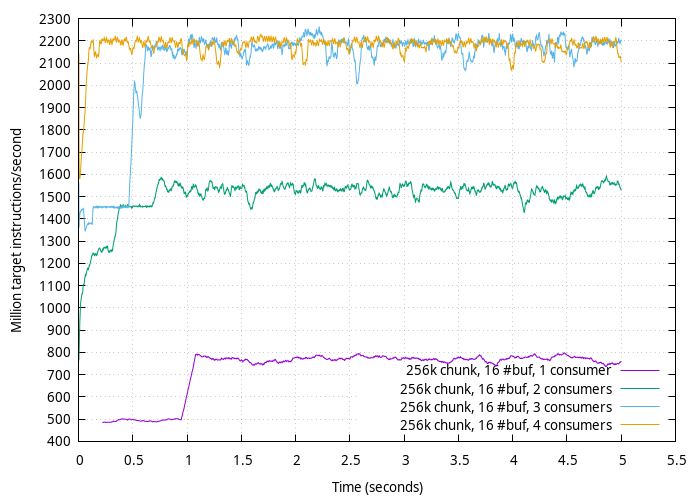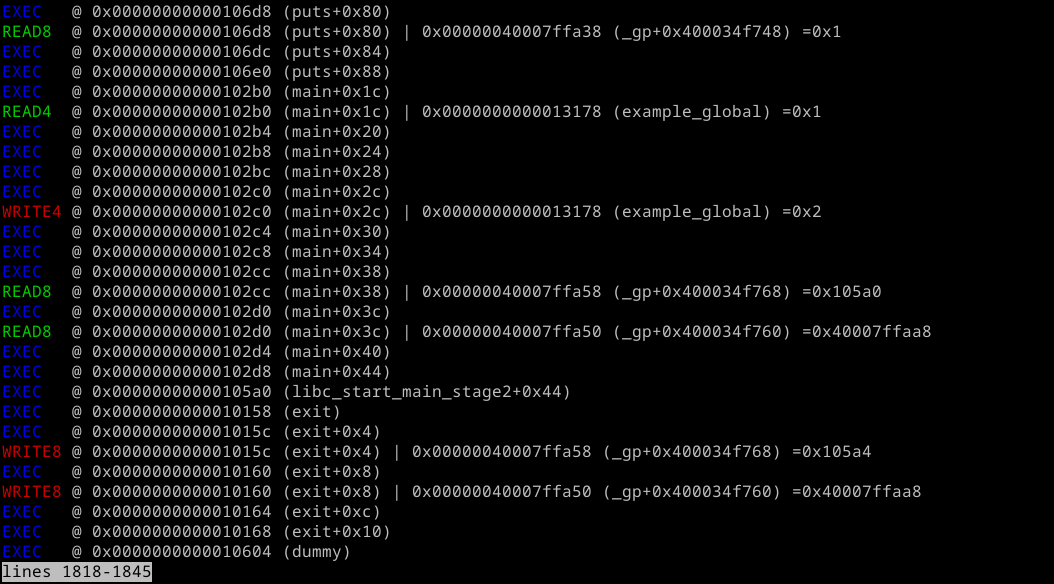Cannoli is a high-performance tracing engine for qemu-user. It can record a trace of both PCs executed, as well as memory operations. It consists of a small patch to QEMU to expose locations to inject some code directly into the JIT, a shared library which is loaded into QEMU to decide what and how to instrument, and a final library which consumes the stream produced by QEMU in another process, where analysis can be done on the trace.
Cannoli is designed to record this information with minimum interference of QEMU's execution. In practice, this means that QEMU needs to produce a stream of events, and hand them off (very quickly) to another process to handle more complex analysis of them. Doing the analysis during execution of the QEMU JIT itself would dramatically slow down execution.
Cannoli can handle billions of target instructions per second, can handle multi-threaded qemu-user applications, and allows multiple threads to consume the data from a single QEMU thread to parallelize processing of traces.
Performance with a single QEMU thread running the benchmark example on a Intel Xeon Silver 4310 @ 2.1 GHz, target is mipsel-linux, hot loop of unrolled nops to benchmark PC tracing bandwidth (worst case for us)
For an example, check out the symbolizer! Here's the kind of information you can get!
Build Cannoli
git clone https://github.com/MarginResearch/cannoli
cd cannoli
cargo build --release
Checkout QEMU
git clone https://gitlab.com/qemu-project/qemu.git
Switch to the current QEMU branch we're working on
git checkout 00b1faea41d283e931256aa78aa975a369ec3ae6
Apply patch from qemu_patches.patch
cd qemu
git am --3way </path/to/cannoli>/qemu_patches.patch
Build QEMU for your desired targets (example mipsel and riscv64)
./configure --target-list=mipsel-linux-user,riscv64-linux-user --extra-ldflags="-ldl" --with-cannoli=</path/to/cannoli>
make -j48
Try out the example symbolizer
In one terminal, start the symbolizer
cd examples/symbolizer
cargo run --release
In another terminal, run the program in QEMU with Cannoli!
cd examples/symbolizer
</path/to/qemu>/build/qemu-mipsel -cannoli </path/to/cannoli>/target/release/<your jitter so>.so ./example_app
Cannoli can be used to get coverage of binary applications for pretty cheap. There's an example provided that uses terrible symbol resolution, but it gives you a rough idea of what you can do
Build and run the client:
cd cannoli/examples/coverage
cargo run --release
Invoke QEMU on a binary you want coverage of, using the coverage hooks
QEMU_CANNOLI=cannoli/target/release/libcoverage.so qemu/build/qemu-x86_64 /usr/bin/vlc
This should work even for large, many-threaded applications! The coverage is self-silencing, meaning it will disable reporting of coverage (in the JIT) by patching itself out once it executes for the first time. You might get events in the future for the same callbacks due to re-JITting of the same code, but it's just meant to be a major filter to cut down on the traffic that you would otherwise get will full tracing.
- Create an application using the
cannolilibrary to process traces by implementing theCannolitrait (see one of theexamples) - Create a library using the
jitterlibrary to filter JIT hooks by implementinghook_instandhook_mem, this must be acdylibthat produces the.sothat you pass into QEMU with--cannoli. For a basic example of this that hooks everything, seejitter_always - Run your trace-parsing application
- Launch QEMU with the
-cannoliargument, and a path to the compiled<jitter>.sothat you built!
To start off, we should cover what you should expect as an end-user.
As a user you will have to apply a small patch set to QEMU, consisting of about
200 lines of additions. These are all gated with #ifdef CANNOLI, such that if
CANNOLI is not defined, QEMU will build identically to having none of the
patches in the first place.
The patches aren't too relevant to the user, other than understanding that they
add a -cannoli flag to QEMU which expects a path to a shared library. This
shared library is loaded into QEMU and is invoked at various points of the JIT.
To apply the patches, simply run something like:
git am qemu_patches.patch
The shared library which is loaded into QEMU is called the Cannoli Jitter.
Using this library expects two basic callbacks to be implemented, such that QEMU knows when to hook, and how to hook, certain operations. This is the filter mechanism that prevents JIT code from being produced in the first place if you do not want to hook literally everything.
use jitter::HookType;
/// Called before an instruction is lifted in QEMU.
///
/// The `HookType` dictates the type of hook used for the instruction, and may
/// be `Never`, `Always`, and `Once`
///
/// This may be called from multiple threads
#[no_mangle]
fn hook_inst(_pc: u64, _branch: bool) -> HookType {
HookType::Always
}
/// Called when a memory access is being lifted in QEMU. Returning `true` will
/// cause the memory access to generate events in the trace buffer.
///
/// This may be called from multiple threads
#[no_mangle]
fn hook_mem(_pc: u64, _write: bool, _size: usize) -> bool {
true
}These hooks provide an opportunity for a user to decide whether or not a given
instruction or memory access should be hooked. Returning true (the default)
results in instrumenting the instruction. Returning false means that no
instrumentation is added to the JIT, and thus, QEMU runs with full speed
emulation.
This API is invoked when QEMU lifts target instructions. Lifting in this case, is the core operation of an emulator, where it disassembles a target instruction, and transforms it into an IL or JITs it to another architecture for execution. Since QEMU caches instructions it has already lifted, these functions are called "rarely" (with respect to how often the instructions themselves execute), and thus this is the location where you should put in your smart logic to filter what you hook.
If you hook a select few instructions, the performance overhead of this tool is effectively zero. Cannoli is designed to provide very low overhead for full tracing, however if you don't need full tracing you should filter at this stage. This prevents the JIT from being instrumented in the first place, and provides a filtering mechanism for an end-user.
Cannoli then has a client component. The client's goal is to process the massive stream of data being produced by QEMU. Further, the API for Cannoli has been designed with threading in mind, such that a single thread can be running inside qemu-user, and complex analysis of that stream can be done by threading the analysis while getting maximum single-core performance in QEMU itself.
Cannoli exposes a standard Rust trait-style interface, where you implement
Cannoli on your structure.
As an implementer of this trait, you must implement init. This is where you
create a structure for both a single-threaded mutable context (Self), as well
as a multi-threaded shared immutable context (Self::Context).
You then optionally can implement the callbacks for the Cannoli trait.
These callbacks are relatively self-explanatory, with the exception of the
threading aspects. The three main execution callbacks exec, read, and
write can be called from multiple threads in parallel. Thus, these are not
called sequentially. This is where stateless processing should be done. These
also only have immutable access to the Self::Context, as they run in
parallel. This is the correct location to do any processing which does not need
to know the ordering/sequence of instructions or memory accesses. For example,
applying symbols where you convert from a pc into a symbol + address should
be done here, such that you can symbolize the trace in parallel.
All of the main callbacks (eg. exec) provide access to a trace buffer.
Pushing values of type Self::Trace to this buffer allow you to sequence data.
Pushing events to this buffer allows them to be viewed in-execution-order
when the trace is processed in the trace() callback.
This trace is then exposed back to the user fully in-order via the trace
callback. The trace callback is called from various threads (eg. you might
run in a different TID), however, is it ensured to always be called
sequentially and in-order with respect to execution. Due to this, you get
mutable access to self, as well as a reference to the shared Self::Context.
I know this is a weird API, but it effectively allows parallelism of processing the trace until you absolutely need it to be sequential. I hope it's not too confusing for end users, but processing 2 billion instructions/second of data kind of requires threading on the consumer side, otherwise you bottleneck QEMU!


